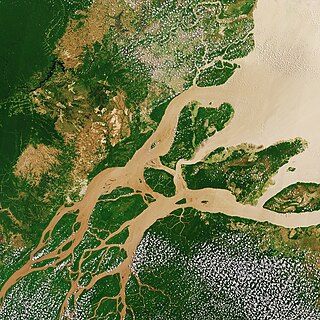
The Amazon River in South America is the largest river by discharge volume of water in the world, and the longest or second-longest river system in the world, a title which is disputed with the Nile.
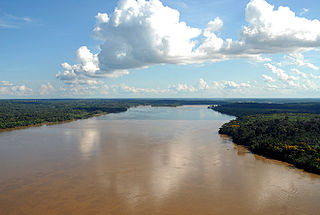
The Madeira River is a major waterway in South America. It is estimated to be 1,450 km (900 mi) in length, while the Madeira-Mamoré is estimated near 3,250 km (2,020 mi) or 3,380 km (2,100 mi) in length depending on the measuring party and their methods. The Madeira is the biggest tributary of the Amazon, accounting for about 15% of the water in the basin. A map from Emanuel Bowen in 1747, held by the David Rumsey Map Collection, refers to the Madeira by the pre-colonial, indigenous name Cuyari.
The River of Cuyari, called by the Portuguese Madeira or the Wood River, is formed by two great rivers, which join near its mouth. It was by this River, that the Nation of Topinambes passed into the River Amazon.

Amazonas is a state of Brazil, located in the North Region in the north-western corner of the country. It is the largest Brazilian state by area and the ninth-largest country subdivision in the world with an area of 1,570,745.7 square kilometers. It is the largest country subdivision in South America, being greater than the areas of Chile, Paraguay, and Uruguay combined. Neighbouring states are Roraima, Pará, Mato Grosso, Rondônia, and Acre. It also borders the nations of Peru, Colombia and Venezuela. This includes the Departments of Amazonas, Vaupés and Guainía in Colombia, as well as the Amazonas state in Venezuela, and the Loreto Region in Peru.

The Rio Negro, or Guainía as it is known in its upper part, is the largest left tributary of the Amazon River, the largest blackwater river in the world, and one of the world's ten largest rivers by average discharge. Despite its high flow, the Rio Negro has a low sediment load.

Manaus is the capital and largest city of the Brazilian state of Amazonas. It is the seventh-largest city in Brazil, with an estimated 2022 population of 2,063,689 distributed over a land area of about 11,401 km2 (4,402 sq mi). Located at the east centre of the state, the city is the centre of the Manaus metropolitan area and the largest metropolitan area in the North Region of Brazil by urban landmass. It is situated near the confluence of the Negro and Amazon rivers. It is one of the two cities in the Amazon Rainforest with a population of over 1 million people, alongside Belém.

The North Region of Brazil is the largest region of Brazil, accounting for 45.27% of the national territory. It has the second-lowest population of any region in the country, and accounts for a minor percentage of the national GDP. The region is slightly larger than India and slightly smaller than the whole European Union. It comprises the states of Acre, Amapá, Amazonas, Pará, Rondônia, Roraima, and Tocantins.

The Federal University of Amazonas is a public university located in Manaus, Amazonas, Brazil. It is the oldest university in Brazil and one of the largest universities in the northern region of Brazil.

The Amazon rubber cycle or boom was an important part of the socioeconomic history of Brazil and Amazonian regions of neighboring countries, being related to the commercialization of rubber and the genocide of indigenous peoples.

Novo Airão is a municipality located in the state of Amazonas in northern Brazil on the Rio Negro River about 180 km upstream of Manaus. Its population was 19,928 (2020) and its area is 37,771 km2. The town is accessible by both river and road.
Amazonian Jews are the Jews of the Amazon basin, mainly descendants of Moroccan Jews who migrated to northern Brazil and Peru in the 19th and early 20th centuries. The migrants were attracted to the growing trade in the Amazon region, especially during the rubber boom, as well as to the newly established religious tolerance. They settled in localities along the Amazon River, such as Belém, Cametá, Santarém, Óbidos, Parintins, Itacoatiara and Manaus in Brazil, some venturing as far as Iquitos in Peru.

This is a timeline of Amazon history, which dates back at least 11,000 years ago, when humans left indications of their presence in Caverna da Pedra Pintada.

The Journalist Phelippe Daou Bridge is the fourth longest bridge in Brazil at 3,595 metres (11,795 ft) long, with a cable-stayed bridge section of 400 metres (1,300 ft), over the Rio Negro that links the city of Manaus with the small town of Iranduba in the state of Amazonas in Brazil. It spans the Rio Negro just before its confluence with the Amazon River, and is the only major bridge across the Amazon or any tributary in the Amazon basin. Its construction was marked by controversy over the potential effects of roadbuilding in the Amazon basin, which could lead to deforestation. A 2018 study found that the construction of this bridge did induce deforestation.

The Acre War, known in Brazil as Acrean Revolution and in Spanish as Guerra del Acre was a border conflict between Bolivia and Brazil over the Acre Region, which was rich in rubber and gold deposits. The conflict had two phases between 1899 and 1903, and ended with an Acrean victory and the subsequent Treaty of Petrópolis, which ceded Acre to Brazil. The outcome also affected territories disputed with Peru.
The following is a timeline of the history of the city of Manaus, in Amazonas state, Brazil.

Isaac Benayon Sabba was a Brazilian entrepreneur. He founded the IB Sabbá Ltda. group and Petroleo Sabbá S.A., the largest business group operating on the Brazilian Amazon region during the twentieth century.
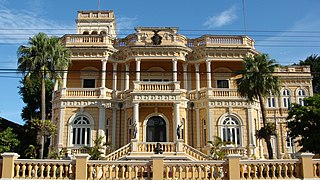
The Palácio Rio Negro in Manaus, Brazil, is a former seat of government and residence of the governor of the state of Amazonas. The original name was Scholz Palace, built by the German entrepreneur Karl Waldemar Scholz, who was considered to be a "Rubber Baron". The name was changed to Palácio Rio Negro in 1918 when the palace was purchased by the governor of the Brazilian state of Amazonas, Pedro de Alcântara Bacellar.
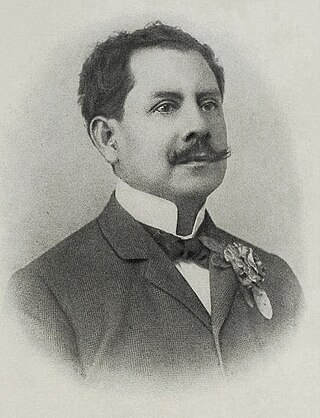
Silvério José Nery (Neri) was a Brazilian soldier and politician who was a federal deputy from 1897 to 1899, governor of the state of Amazonas from 1900 to 1903 and a senator from 1904 to 1930.

The history of Manaus, with over 350 years of existence, coincides with the history of Brazil. The process of European occupation began in the middle of the 16th century, when explorer Francisco de Orellana arrived from Peru and intended to go to Spain.
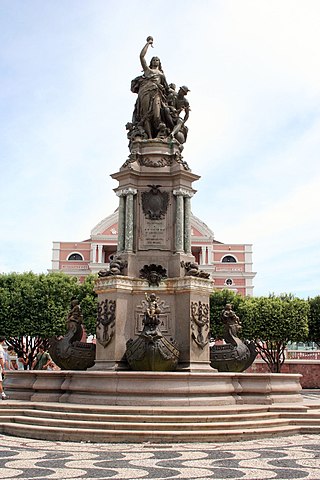
Monument Abertura dos Portos is located in the Largo de São Sebastião, in front of the Amazon Theatre, in the city of Manaus, Brazil. It was inaugurated in 1900 to commemorate the liberation of the ports of the Amazon River to foreign trade, in 1866.

The history of Amazonas is the result of treaties, religious missions and a few indigenous rebellions in the Amazon territory. Initially, under the Treaty of Tordesillas, the site belonged to the Spanish Kingdom, but was later annexed by the Portuguese Crown. The state's international borders, undefined after Brazil's independence in 1822, were demarcated during the signing of the Treaty of Bogotá. Archaeological research suggests past occupations by Paleo-Indian hunter-gatherer groups, dated around 11,200 years before the present day.






















